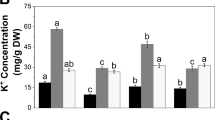Abstract
The aim of this research is the early identification of distinctive responses to NaCl in rice cultivars that would indicate further stress-related effects in mature plants. For this purpose, we analysed some developmental and anatomical features in control and NaCl-stressed seedlings of two Japonica rice cultivars (Bomba and Bahia). Responses ascribed to osmotic stress were differentiated from those related to the ionic component of salinity by using in parallel a non-penetrating osmoticum (sorbitol). The general patterns of reduction in growth and variations in anatomical features of second leaf sections were similar in both cultivars. The main difference between them was the intensity of the response as a function of the stress agent. In general, the effect of NaCl was significantly stronger than that of sorbitol in cv. Bomba, whereas in cv. Bahia the effects of both stress agents were comparable. In this regard, the size of epidermal and bulliform cells as well as dimensions related to the vascular system, including xylem vessels, increased significantly in NaCl-stressed cv. Bomba leaves. This enlargement of xylem vessels agrees with the observed decrease in the rate of eosin transport and appears to be a distinctive anatomical indicator of NaCl sensitivity. The further impact of salinity on grain yield was proved to be stronger in cv. Bomba plants than in those of cv. Bahia.



Similar content being viewed by others
References
Alam MZ, Stuchbury T, Naylor REL, Rashid MA (2004) Effect of salinity on growth of some modern rice cultivars. J Agron 3:1–10
Ashraf M, Harris PJC (2004) Potential biochemical indicators of salinity tolerance in plants. Plant Sci 166:3–16
Bahaji A, Mateu I, Sanz A, Cornejo MJ (2002) Common and distinctive responses of rice seedlings to saline- and osmotically-generated stress. Plant Growth Regul 38:83–94
Baum SF, Tran PN, Silk WK (2000) Effects of salinity on xylem structure and water use in growing leaves of sorghum. New Phytol 146:119–127
Boughalleb F, Denden M, Tiba BB (2009) Anatomical changes induced by increasing NaCl salinity in three fodder shrubs, Nitraria retusa, Artiplex halimus and Medicago arborea. Acta Physiol Plant 31:947–960
Flowers TJ (2004) Improving crop salt tolerance. J Exp Bot 55:307–319
Gregorio GB, Senadhira D, Mendoza RD, Manigbas NL, Roxas JP, Guerta CQ (2002) Progress in breeding for salinity tolerance and associated abiotic stresses in rice. Field Crops Res 76:91–101
Hameed M, Ashraf M, Naz N (2009) Anatomical adaptations to salinity in cogon grass [Imperata cylindrica (L.) Raeuschel] from the salt range, Pakistan. Plant Soil 322:229–238
Joshi AJ, Mali BS, Hinglajia H (2005) Salt tolerance at germination and early growth of two forage grasses growing in marshy habitats. Environ Exp Bot 54:267–274
Khatun S, Flowers TJ (1995) Effects of salinity on seed set in rice. Plant Cell Environ 18:61–67
Larcher W (2003) Physiological plant ecology—ecophysiology and stress physiology of functional groups, 4th edn. Springer, Berlin
Lee KS, Choi WY, Ko JC, Kim TS, Gregorio GB (2003) Salinity tolerance of japonica and indica rice (Oryza sativa L.) at the seedling stage. Planta 216:1043–1046
Lutts S, Kinet JM, Bouharmont J (1995) Changes in plant response to NaCl during development of rice (Oryza sativa L.) varieties differing in salinity resistance. J Exp Bot 46:1843–1852
Mateu-Andrés I (1991) Leaf anatomy of plants from coastal Mediterranean salt-marshes. Monocotyledons. Candollea 46:345–358
Moukadiri O, Deming J, O’Connor JE, Cornejo MJ (1999) Phenotypic characterization of the progenies of rice plants derived from cryopreserved calli. Plant Cell Rep 18:625–632
Munns R (2002) Comparative physiology of salt and water stress. Plant Cell Environ 25:239–250
Munns R (2005) Genes and salt tolerance: bringing them together. New Phytol 167:645–663
Munns R, James RA, Läuchli A (2006) Approaches to increasing the salt tolerance of wheat and other cereals. J Exp Bot 57:1025–1043
Rao SP, Mishra B, Gupta SR, Rathore A (2008) Reproductive stage tolerance to salinity and alkalinity stresses in rice genotypes. Plant Breed 127:256–261
Sahi C, Singh A, Kumar K, Blumwald E, Grover A (2006) Salt stress response in rice: genetics, molecular biology, and comparative genomics. Funct Integr Genomics 6:263–284
Singh MP, Singh DK, Rai M (2007) Assessment of growth, physiological and biochemical parameters and activities of antioxidative enzymes in salinity tolerant and sensitive basmati rice varieties. J Agron Crop Sci 193:398–412
Sobrado MA (2007) Relationship of water transport to anatomical features in the mangrove Laguncularia racemosa grown under contrasting salinity. New Phytol 173:584–591
Tester M, Bacic A (2005) Abiotic stress tolerance in grasses. From model plants to crop plants. Plant Physiol 137:791–793
Wankhade SD, Cornejo MJ, Mateu-Andrés I (2010) Microsatellite marker-based genetic variability in Spanish rice cultivars and landraces. Span J Agric Res (in press)
Yamaguchi T, Blumwald E (2005) Developing salt-tolerant crop plants: challenges and opportunities. Trends Plant Sci 10:615–620
Acknowledgments
We thank our colleague Dr. A. Sanz and Drs. R. Ballesteros and R. Carreres from the Department of Rice, Valencian Institute of Agronomic Investigations (IVIA) for their collaboration. Shantanu D. Wankhade was a fellow of the Spanish Agency for International Cooperation (AECI). This research was financed by the Generalitat Valenciana (GRUPOS 2005-034).
Author information
Authors and Affiliations
Corresponding author
Additional information
Communicated by W. Filek.
Rights and permissions
About this article
Cite this article
Wankhade, S.D., Bahaji, A., Mateu-Andrés, I. et al. Phenotypic indicators of NaCl tolerance levels in rice seedlings: variations in development and leaf anatomy. Acta Physiol Plant 32, 1161–1169 (2010). https://doi.org/10.1007/s11738-010-0511-0
Received:
Revised:
Accepted:
Published:
Issue Date:
DOI: https://doi.org/10.1007/s11738-010-0511-0




